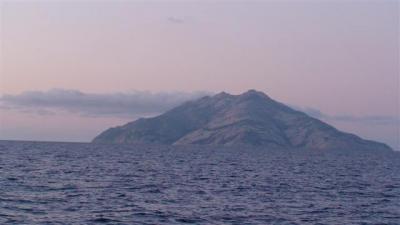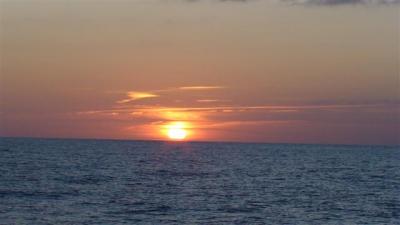Yesterday we had a low key day. Since we were leaving later in the day, we took our time with our get ready to go routine. We pulled out of port at 1600.
For those of you that asked about marina specifics, we have found that the front of the boat moves an awful lot being secured only to one mooring line instead of two. The marina is also not super flat. Rolly may be too strong of a word, but the side to side movement combined with the gentle swell activity is certainly noticeable enough to make someone sensitive to motion not feel good.
Anyway, when we pulled out, the winds were moderate. Seas were the usual — small, sharp, rapid and very uncomfortable. Waves were also a bit confused, which made both of us feel green all evening. We were making good time, doing 6.6 knots at 1700 RPM.
The sunset was really cool and unusual. The sun turned fiery red and made the entire sky a deep crimson color. But the sky was covered in dark gray clouds, so it gave the effect of dark gray with spots of red and pink glowing in it. Also, the sun itself was cloud free, so we could watch it go down while simultaneously enjoying the psychedelic effect in the rest of the sky. The moon was pretty well completely blocked by clouds, making visibility poor after dark.
In the wee hours of the morning, we got into the shadow of Corsica where the waters are more protected. The wind totally died and the ride became smooth and pleasant. We had to lower the RPM’s because we were going too fast. We cranked it down to 1600 RPM and were still doing a solid 6.2 knots per hour.
As the days went on, it got even calmer and nicer. We watched sailboats motoring along, their sails hanging limply, looking more like sheets on a clothesline than sails. There are a lot of small islands that dot the area, and all day we weaved in between them. Most scenic.

We expected the seas to be rough and miserable when we came around the corner of Corsica, thus leaving the protected area. The seas did pick up some, but the wind was dead and it was an unexpectedly pleasant ride.
Tonight the sunset was nice, but less dramatic. There are less clouds in the sky, and the half full moon peeks out from time to time, giving off a little light to help make the night less ominous.

We hit another milestone today! We passed the 21,600 nautical mile mark. Why is that significant? 21,600 is the circumference of the earth. If we had gone in a perfectly straight line around the equator, we would already be back home.
And, on to some blog questions:
Q: Why did you have to hire a pilot to go through the Suez Canal? Isn’t this the first time you’ve blogged about that?
A: Large ships often have to hire pilots to go into harbors, canals, and so forth. San Diego Bay is a perfect example of that. The logic is they want someone who is very familiar with all the hazards within the water steering the ship to prevent potential accidents. San Diego Bay is a natural bay, and it is naturally very shallow. Many a boat has sunk thinking the water is deeper than it is. A narrow channel has been dredged in the middle of the bay to accommodate large ships (as an FYI, Harbor Blvd, Harbor Island and Shelter Island have all been made from the bay dredgings). But if that big ship steers a little too far left or right it can easily hit bottom and sink. Hence, the knowledgeable pilot.
Usually, bays and canals and such are safe for most boats, and only especially large vessels have to worry (in most cases the bigger above the water, the bigger below the water). So, normally, small boats don’t need pilots. But the Suez Canal is very busy and very narrow, so we suppose they feel a pilot on every boat is a diligent safety precaution.
Q: Can you describe your schedule when it is just you and Christi making a long passage? What works best as far as how you take turns running the boat, how you do the engine room checks, do you sleep in the pilot house, do you leave the helm unattended during engine room checks and bathroom breaks (if the other party is sleeping)?
A: At sea, we do a minimum of 4 hour watches. So, when my 4 hours are up, if I don’t want to do watch anymore, I go wake up Eric. If my 4 hours are up and I am wide awake and content to stay on watch, I will just stay in the pilot house until I need a break, then go and get him. And vice versa. In rough seas and/or at night, we are generally done at the 4 hour mark. In calmer weather and/or day (or we’ve been out long enough that we are fully acclimated to being up at night), we will often stay longer to give the other more sleep.
We will nap on watch if tired. We set a small timer for 15 minutes. When the alarm goes off, we look around, reset the timer, and go back to sleep again. The radar alarm is set, so if something gets close while we are asleep, it should go off and wake us up.
We do leave the helm to go to the bathroom and do engine room checks and get something to eat (though we eat in the pilot house). We do an engine room check and fill out the log book at the start of each watch. We’ll add additional log entries if anything out of the normal happens, as well.

Yeah calm seas.. you both have had your fair shar of rough waters. Beautiful sunset too!!